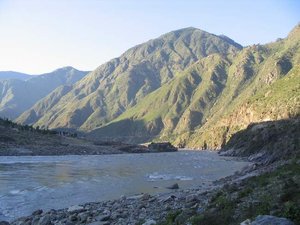Indus River
|
|
The Indus (सिन्धु नदी) (known as Sindhu to Indians and in Sanskrit, as Sinthos in Greek, and Sindus in Latin) is the principal river of Pakistan. Before the partition of India into the modern states of India and Pakistan in 1947, The Indus was second only to the Ganges in terms of cultural and commercial importance for the region, and also gave its name to the country of India. The river originates in Tibet, flowing from the Himalayas in a north-westerly direction through Kashmir, and then turning south for nearly the entire length of Pakistan. Figures for the total length of the river vary between 2900 and 3200 km. The Indus Valley Civilization had some of the earliest urban settlements in the world.

| Contents |
Course and Hydrology
Course
The ultimate source of the Indus is actually in Tibet; it begins at the confluence of the Sengge River and Gar River that drain the Nganglong Kangri and Gangdise Shan ranges. The Indus then flows northwest through Gilgit-Baltistan just south of the Karakoram range, then gradually bends to the south, coming out of the hills between Peshawar and Rawalpindi. It is dammed in this area also, forming the Tarbela Reservoir. The remainder of its route to the sea is in plains of the Punjab and Sind, and the river becomes slow-flowing and highly braided. Passing by Hyderabad, it ends in a large delta to the southeast of Karachi.
Tributaries
- Gilgit River
- Gizar River
- Hunza River
- Gumal River
- Zhob River
- Kabul River
- Kunar River
- Sutlej River
- Shyok River
- Beas River
- Chenab River
- Jhelum River
- Ravi River
Other
The Indus is one of the few rivers in the world that exhibit a tidal bore.
The Indus is, by volume, the largest exotic river (one that mainly flows through country from which it receives no water) in the world.
History and Archeology
The Indus Valley Civilization was one of the oldest urban civilizations in the world. Its name comes from the Sanskrit word for river, 'sindhu', from which the 's' was dropped by its adoption into Persian. This gave the Persians the name of the land associated with the river 'Hindu' and the Greeks, dropping the 'H', 'Indus'. Its name was given to the entire subcontinent by the Romans, who adapted it to the current 'India'.
Wildlife
The Indus River Dolphin, modern genetic studies show, lives both in the Indus River and in the Ganges. The two populations were formerly considered distinct species. It formerly occurred in the tributaries of the Indus also and may have extended into the northwestern extremities of the Indian Province of Punjab. Located southeast of Karachi, the large delta has been recognised by conservationists as one of the world's most important ecological regions.
